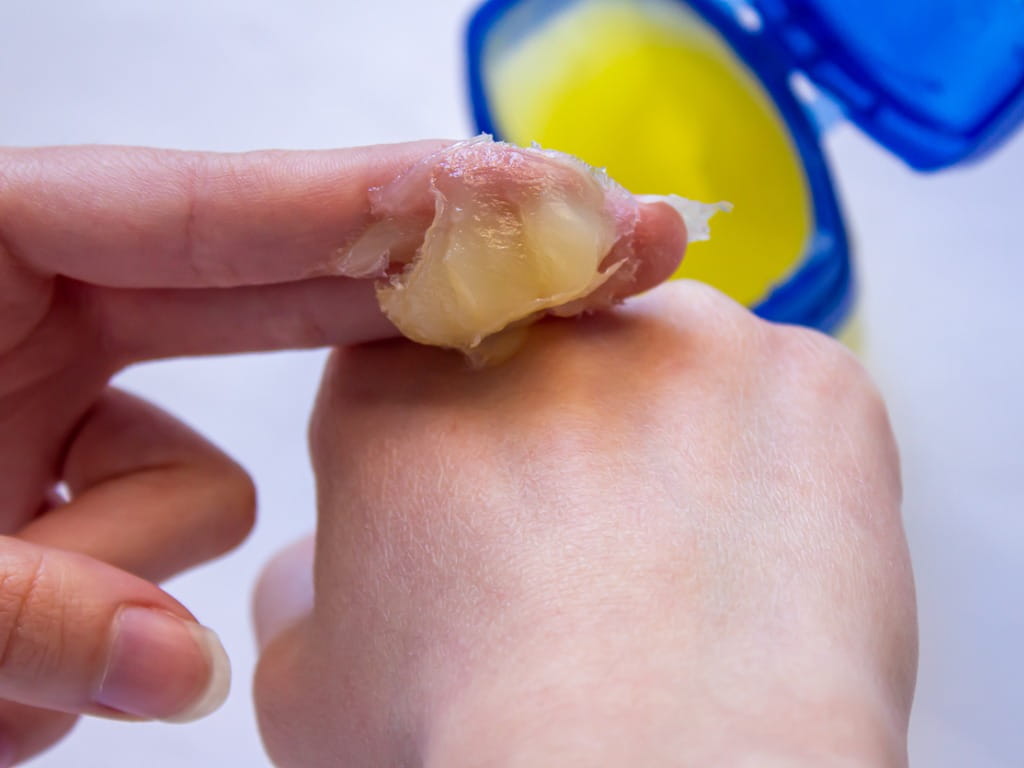What is petroleum jelly?

The Bottom Line
Petroleum jelly, or petrolatum, is a common household product used in many medicated ointments. People also use it as a moisturizer. Petroleum jelly is generally considered nontoxic when consumed in small amounts but should not be applied to the eye or within the nose due to the risk of irritation or other side effects.

What is petrolatum, the ingredient in Vaseline and Aquaphor?
Petroleum jelly, or petrolatum, is comprised of mineral oils and waxes. The main ingredient in products like Aquaphor and Vaseline, petrolatum is an emollient. Emollients moisturize the skin by forming an oily layer that traps moisture in the skin. Petroleum jelly products can prevent and treat dry skin, chafing, and diaper rash and can be used in basic wound care. Also known as petrolatum, it serves as a base for some medications, such as topical antibiotics like Neosporin, to help carry the active ingredient into the skin.Can you use Vaseline as lip balm?
You can safely use petrolatum products such as Vaseline on the lips as a moisturizer, and some petrolatum-based products are available in small tubes specially meant for lip application. You can use petroleum jelly on the face (sometimes called "slugging"), but for some people doing so leads to clogged pores and pimples. It is rare, but some individuals can develop minor skin irritation after petrolatum use. Because you can accidentally inhale petrolatum into the lungs from the nose, avoid applying petroleum jelly inside the nose.Can you put Vaseline in your eyelashes?
You can safely use petroleum jelly products around the eye because they are generally not irritating. However, note that the skin around the eye is quite sensitive and more prone to irritation than other areas. In addition, eye ointments that contain petrolatum are designed and manufactured for ophthalmologic use and are held to higher standards of sterility than ointments used on other areas of the body. For this reason, petrolatum products can be used around the eye but should only be applied in the eye if the product is meant specifically for that purpose. If petrolatum accidentally gets in the eye, rinse the eye with comfortable temperature tap water for 15-20 minutes.Does Vaseline heal wounds?
After cleaning the wound, you can safely apply petroleum jelly products like Aquaphor or Vaseline to minor cuts and burns to help keep injured skin from drying out and forming scabs that can prolong healing and lead to scar formation. If a wound or laceration is large and deep or appears infected (with redness or drainage), seek medical attention before applying petrolatum. In addition, burns that involve sensitive areas of the body, such as the hands, face, and genital area, should be evaluated by a health care professional before applying petrolatum. People undergoing radiation treatment for cancer and have radiation burns should speak with their radiation oncology doctor before applying petrolatum to the burned area. It is also crucial to avoid using petroleum jelly products like Vaseline while smoking or near flames, as they are flammable and may cause burns.Is it safe to apply Aquaphor to tattoos?
More information about whether petrolatum can be used safely on newer tattoos is needed. The manufacturer of Vaseline suggests that the product is safe on tattoos and can help prevent drying out of the skin around a new tattoo. However, some tattoo professionals say that applying petrolatum can trap dirt within a tattoo, leading to infection. Also, some tattoo professionals believe tattoos need air to heal properly. Individuals with tattoos should ask a tattoo professional about specific recommendations for tattoo aftercare. Application of petrolatum products to older or healed tattoos is unlikely to cause harm.Is petroleum jelly toxic?
Petrolatum products are generally not toxic when swallowed. However, because these products are thick and greasy, people can choke on them when ingesting them.Do petroleum jelly products expire?
Petrolatum products do not contain active ingredients, and product quality can remain stable for a long time. Expired petrolatum products are generally not harmful, but you should discard them if they have an abnormal color, odor, or consistency. In addition, touching the inside of a petrolatum ointment container can contaminate the product with germs and dirt.Does petroleum jelly cause cancer?
Unrefined (unprocessed) petrolatum products used in manufacturing and industry contain impurities that may be associated with cancer development. Manufacturers refine petrolatum products meant for human application, meaning they have removed these impurities, and the cancer risk associated with using them is minimal.What should I do if a petroleum jelly product makes me sick?
If someone chokes or has difficulty breathing after swallowing a petrolatum product, call 911 for immediate assistance. If you experience worrisome effects after using a petroleum jelly product, use it by mistake, or use too much, get expert guidance from Poison Control by calling 1 (800) 222-1222 or using webPOISONCONTROL. Both are free of charge, confidential, and available 24 hours a day.Maryann Amirshahi, PharmD, MD, MPH, PhD
Medical Toxicologist
Poisoned?
Call 1-800-222-1222 or
Prevention Tips
- Keep petrolatum products out of the reach of children.
- Wash your hands prior to touching the inside of a jar of petrolatum.
- Seek medical care before applying petrolatum to deep and large cuts, significant burns, and infected wounds.
- Discuss aftercare instructions for new tattoos with your tattoo professional.
This Really Happened
Case #1: A 3-year-old boy swallowed a taste of Vaseline that was on his diaper changing table. He had a brief choking episode and spit it out, but had no other problems. His mother called Poison Control and was advised to monitor him at home.
Case #2: A 9-year-old pug swallowed a portion of a tub of Aquaphor being used for a baby’s diaper rash. He had two episodes of diarrhea but experienced no other problems.
Case #3: A 27-year-old woman applied Vaseline around her eye due to chronic blepharitis (inflammation of the skin at the base of the eyelash). She accidentally got some Vaseline into her eye and developed blurry vision and eye irritation. She called Poison Control and was instructed to rinse the eye with room temperature water for 15 minutes. Her symptoms resolved within an hour.
For More Information
American Academy of Dermatology. Five ways to use petrolatum for skincare.
References
Poisoned?
Call 1-800-222-1222 or
Prevention Tips
- Keep petrolatum products out of the reach of children.
- Wash your hands prior to touching the inside of a jar of petrolatum.
- Seek medical care before applying petrolatum to deep and large cuts, significant burns, and infected wounds.
- Discuss aftercare instructions for new tattoos with your tattoo professional.
This Really Happened
Case #1: A 3-year-old boy swallowed a taste of Vaseline that was on his diaper changing table. He had a brief choking episode and spit it out, but had no other problems. His mother called Poison Control and was advised to monitor him at home.
Case #2: A 9-year-old pug swallowed a portion of a tub of Aquaphor being used for a baby’s diaper rash. He had two episodes of diarrhea but experienced no other problems.
Case #3: A 27-year-old woman applied Vaseline around her eye due to chronic blepharitis (inflammation of the skin at the base of the eyelash). She accidentally got some Vaseline into her eye and developed blurry vision and eye irritation. She called Poison Control and was instructed to rinse the eye with room temperature water for 15 minutes. Her symptoms resolved within an hour.
